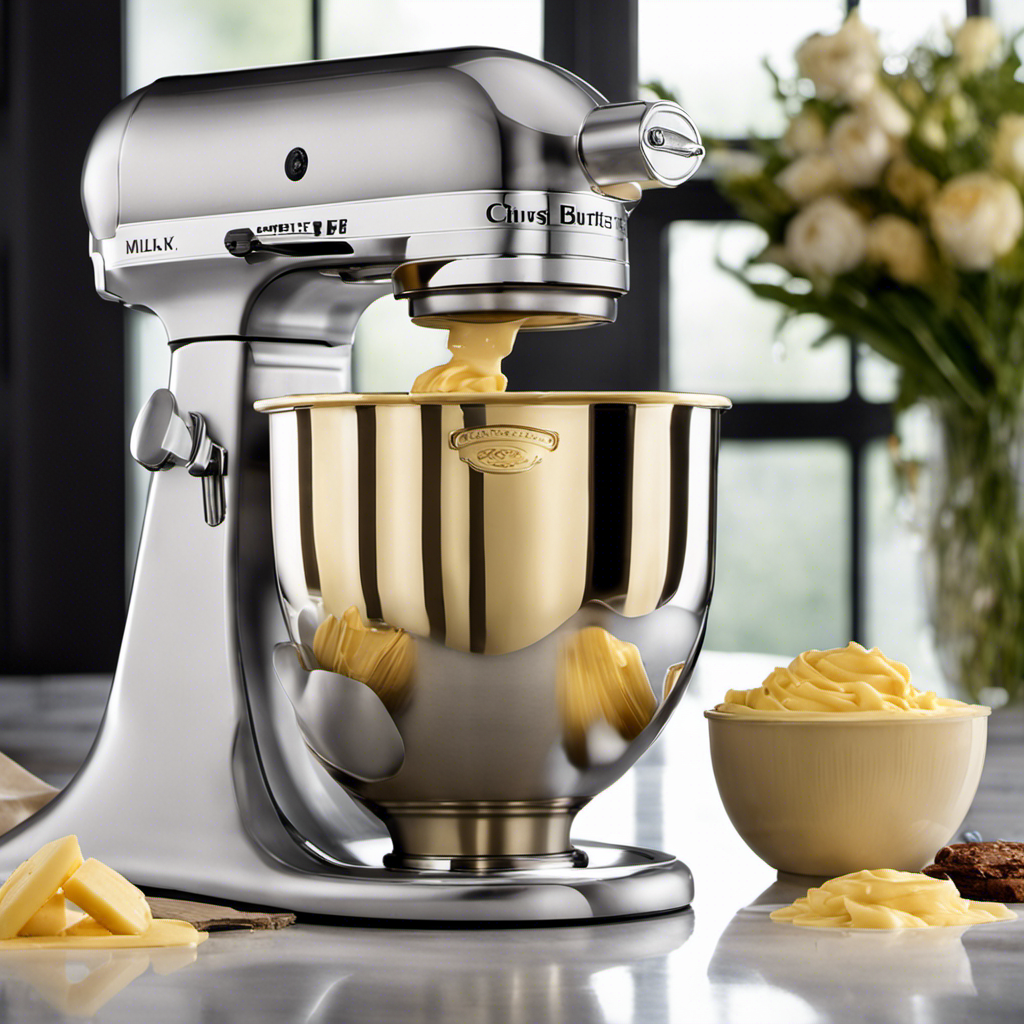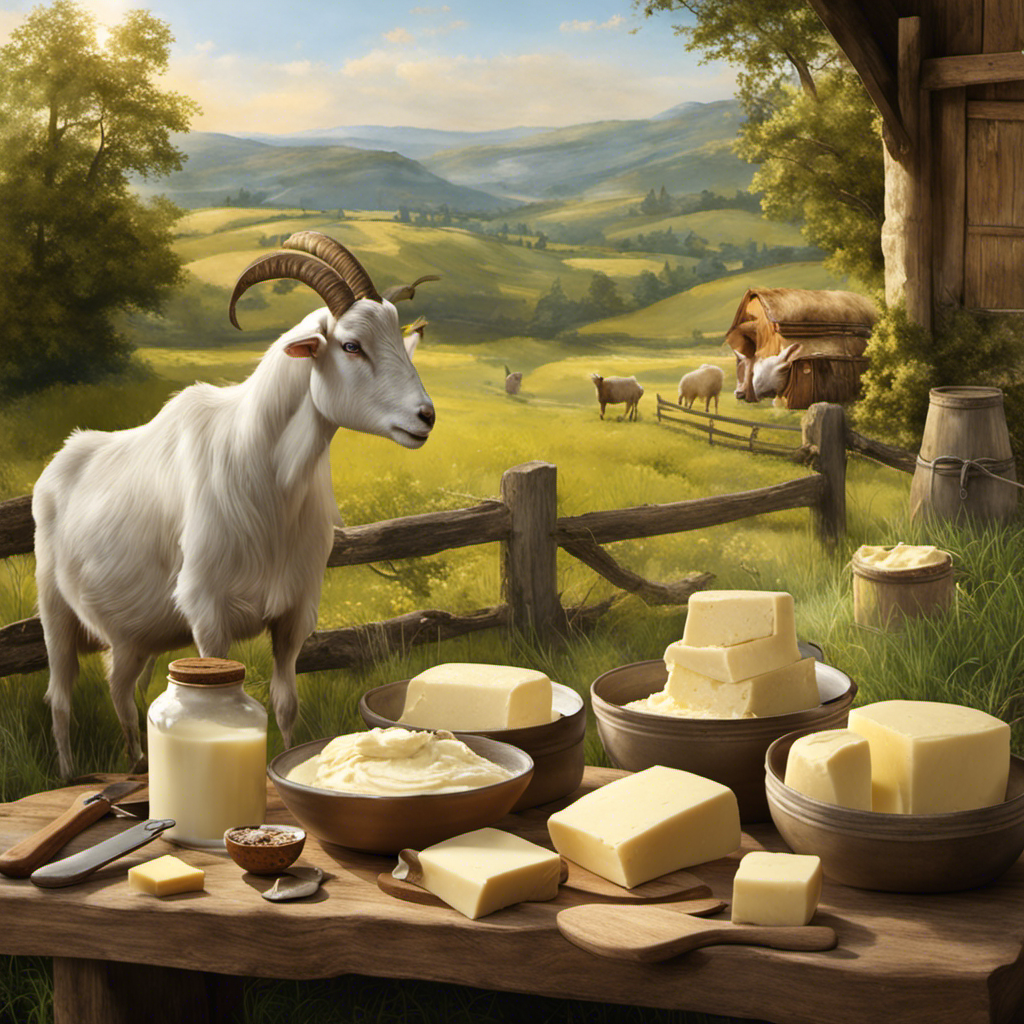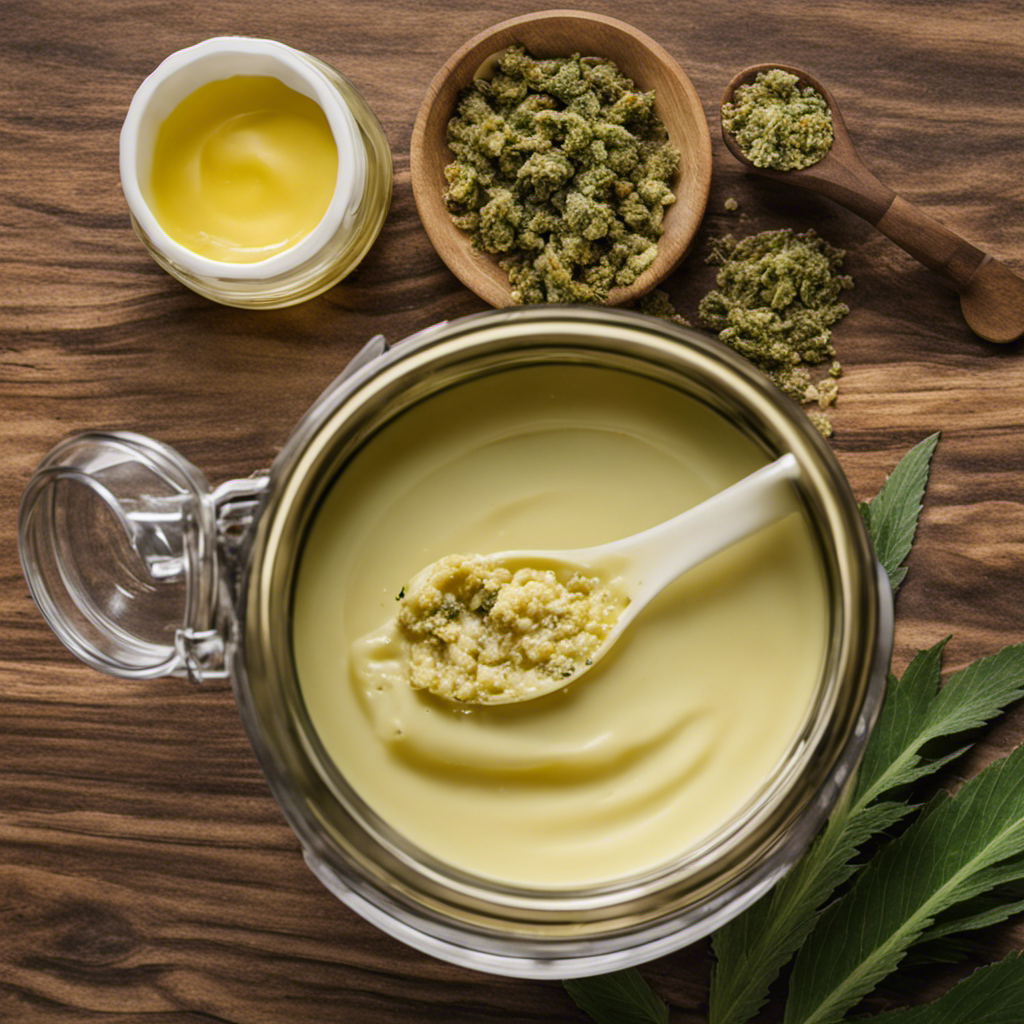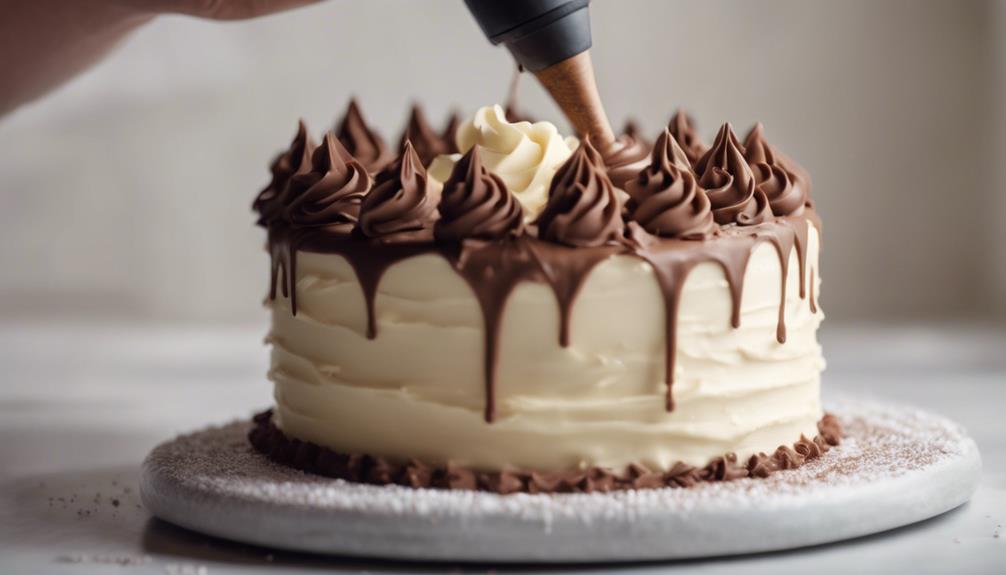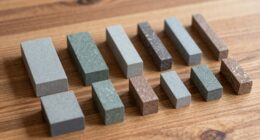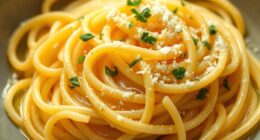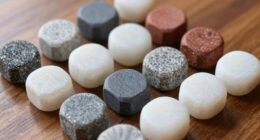Have you ever encountered a recipe that requires 2 ounces of butter, but you’re unsure of the precise measurement? Don’t worry! In this article, I will guide you through the process of measuring butter, including how to convert ounces to grams, utilizing a kitchen scale, and estimating butter weight by volume.
Whether you’re a baking novice or a seasoned chef, this guide will ensure that your butter measurements are always on point. So let’s dive in and unravel the mystery of 2 ounces of butter!
Key Takeaways
- 2 ounces of butter is equal to 1/4 cup or half a stick.
- Familiarizing yourself with butter weight equivalents and practicing measuring by eye can improve accuracy.
- To convert butter from ounces to grams, multiply the number of ounces by 28.35.
- Accurate butter measurement is crucial for achieving desired results in baking and cooking.
The Basics of Butter Measurements
2 ounces of butter is equal to 1/4 cup or half a stick. When it comes to measuring butter, it’s important to have accurate equivalents handy. Butter weight equivalents are helpful in recipes where precise measurements are required. Whether you’re a beginner or an experienced cook, knowing how to measure butter by eye can be a useful skill.
It’s often difficult to determine the exact weight of butter without a scale, but with practice, you can get pretty close. One way to do this is by using the packaging as a guide. Butter sticks are typically marked with measurements, so you can easily cut off the required amount.
Another method is to use a kitchen scale to weigh a full stick of butter, then divide it into equal portions. By familiarizing yourself with these butter weight equivalents and practicing measuring by eye, you’ll be able to confidently add the right amount of butter to your recipes.
Understanding Butter Weight Conversion
Do you know how to convert the weight of butter from ounces? It can be a bit confusing at first, but with a few tips and techniques, you’ll be able to easily understand butter weight conversions.
Here are three key points to keep in mind:
-
Know the conversion factors: To convert butter from ounces to grams, multiply the number of ounces by 28.35. For example, if you have 2 ounces of butter, it would be equal to 56.7 grams. Similarly, to convert from ounces to tablespoons, multiply the number of ounces by 2. So, 2 ounces of butter would be equivalent to 4 tablespoons.
-
Use a kitchen scale: Investing in a good kitchen scale can be incredibly helpful when it comes to accurately measuring butter. This way, you can easily weigh the butter in ounces and convert it to other units as needed.
-
Understand the different butter measurements: Butter is often sold in sticks, cups, or grams. Knowing how these different measurements relate to each other can make your baking or cooking experience much smoother.
Converting Ounces to Grams for Butter
Investing in a kitchen scale can greatly assist in accurately measuring and converting the weight of butter from ounces to grams. A kitchen scale allows you to get the exact measurements you need to follow a recipe perfectly. Precision is key when it comes to converting ounces to grams for butter. To convert ounces to grams, simply multiply the number of ounces by 28.35. For example, if you have 4 ounces of butter, it would be equivalent to 113.4 grams. This conversion is especially useful when dealing with international recipes that use the metric system. So, if you’re looking to achieve culinary success and ensure your butter measurements are spot-on, investing in a kitchen scale is a must.
Measuring Butter Using a Kitchen Scale
When using a kitchen scale, you’ll be able to accurately measure the weight of your butter. This is especially important when following a recipe that requires precise measurements.
Here are three reasons why a kitchen scale is essential for measuring butter:
-
Accuracy: A kitchen scale allows you to measure the exact weight of your butter, ensuring you add the correct amount to your recipe. This is particularly useful when baking, where even a small variation in ingredient quantities can affect the final result.
-
Consistency: By using a kitchen scale, you can ensure that each time you make a recipe, you’re adding the same amount of butter. This helps maintain consistency in your dishes and prevents any unexpected variations in taste or texture.
-
Easy Conversions: If a recipe calls for butter in tablespoons instead of ounces, a kitchen scale can still come in handy. By weighing your butter, you can easily convert the weight to tablespoons using a conversion chart or online calculator.
Overall, a kitchen scale is a valuable tool for accurately measuring butter and ensuring successful cooking and baking results.
Using Common Household Items for Butter Measurement
When it comes to measuring ingredients in the kitchen, we often rely on traditional measuring tools like measuring cups and spoons. However, there are alternative measuring tools that can provide even greater precision in measurements.
In this discussion, we will explore these alternative measuring tools and their benefits, as well as the importance of precision when it comes to achieving culinary perfection.
Alternative Measuring Tools
Using alternative measuring tools can be helpful when trying to measure ingredients like butter. Here are three options that can make your cooking experience easier:
-
Butter molds: These handy tools are designed to hold a specific amount of butter, usually marked in tablespoons or ounces. Simply fill the mold with softened butter and level it off for an accurate measurement.
-
Measuring butter by tablespoons: If you don’t have a butter mold, you can use a tablespoon as a rough guide. One tablespoon of butter is approximately equal to 0.5 ounces. This method is quick and convenient when you need a small amount of butter for a recipe.
-
Online conversion tools: Another alternative is to use online conversion tools that can convert butter measurements from ounces to tablespoons or vice versa. These tools provide precise measurements and can be useful if you need to convert larger quantities of butter.
Precision in Measurements
To ensure precise measurements in your culinary creations, it’s important to use alternative measuring tools like butter molds or online conversion tools. Accuracy is key when it comes to cooking and baking, as even a slight variation in measurements can greatly affect the outcome of your dish.
When it comes to measuring ingredients like butter, using a precise measurement is crucial. A common question that arises in the kitchen is "how much is 2 ounces of butter?" Well, let me break it down for you:
| Measurement | Equivalent |
|---|---|
| 1 stick | 4 ounces |
| 1/2 stick | 2 ounces |
| 1/4 stick | 1 ounce |
Knowing these equivalents can help you achieve the perfect balance of flavors and textures in your recipes. So, the next time you’re cooking, remember the importance of accurate measurements and use the right tools to ensure precision in your culinary creations.
Estimating Butter Weight by Volume
If you’re unsure about how much 2 ounces of butter is, try estimating the weight by volume instead. When you don’t have a kitchen scale handy, using a tablespoon can be a helpful way to measure butter. Here’s how you can estimate the weight of butter using a tablespoon:
- Start by softening the butter to room temperature, so it’s easier to work with.
- Take a tablespoon and scoop out a level amount of butter.
- Use the back of a knife to level off the top of the butter in the tablespoon.
- Repeat this process until you have the desired amount of butter.
Butter Equivalents for Baking and Cooking
When it comes to baking and cooking, accurate butter measurement is crucial for achieving the desired results. Knowing the equivalents for 2 ounces of butter can be especially helpful when you don’t have a kitchen scale on hand.
In this discussion, we will explore different substitutes that can be used in place of 2 ounces of butter, ensuring that your recipes turn out just as delicious.
Accurate Butter Measurement
Measuring accurately, 2 ounces of butter is equivalent to about 4 tablespoons. When it comes to accurately measuring butter, it’s important to have alternatives and a conversion table on hand. Here are three helpful tips:
-
Use a kitchen scale: Weighing the butter on a kitchen scale is the most accurate method. Simply place a bowl on the scale, set it to zero, and add the desired amount of butter.
-
Use a butter measurement conversion table: These tables provide measurements for different forms of butter, such as sticks, tablespoons, and grams. They are a handy reference when following recipes that require precise measurements.
-
Use markings on the butter wrapper: Many butter sticks have markings on the wrapper, indicating tablespoon measurements. Simply cut along the markings to get the desired amount.
Now that we know how to accurately measure butter, let’s explore some substitutes for 2 ounces.
Substitutes for 2 Ounces
To find suitable substitutes for 2 ounces of butter, you can try using ingredients like coconut oil or mashed avocado. These alternatives provide a healthier option while still maintaining the desired texture and flavor in your recipes. Here is a table showcasing some common substitutes for measuring butter:
| Substitute | Measurement |
|---|---|
| Coconut oil | 2 ounces |
| Mashed avocado | 2 ounces |
| Greek yogurt | 1/2 cup |
| Applesauce | 1/2 cup |
| Olive oil | 1/4 cup |
These substitutes offer a variety of options depending on your dietary preferences. Whether you are looking for a vegan alternative or simply want to reduce your intake of saturated fats, these butter alternatives can be a great addition to your cooking repertoire. Now that you know about the substitutes for 2 ounces of butter, let’s move on to some tips for accurate butter measurement.
Tips for Accurate Butter Measurement
You can ensure accurate butter measurement by using a kitchen scale and following the guidelines provided. Here are three tips for measuring butter accurately:
-
Use a kitchen scale: A kitchen scale is the most accurate way to measure butter. It allows you to measure the exact weight, ensuring precise measurements for your recipes.
-
Convert measurements: Sometimes, a recipe might call for butter in a different form, such as tablespoons or cups. To convert the measurement, refer to a conversion chart or use online calculators to determine the equivalent amount of butter needed.
-
Soften butter properly: Softened butter is easier to measure accurately. To soften butter, leave it at room temperature for about 30 minutes. It should be soft enough to easily scoop or spread, but not melted.
Frequently Asked Questions
Can I Use Margarine Instead of Butter in Recipes?
Yes, you can use margarine instead of butter in recipes. However, keep in mind the ongoing butter vs margarine debate. Butter offers health benefits like natural fats, while margarine may contain trans fats.
How Long Does Butter Stay Fresh in the Refrigerator?
When storing butter, it’s important to keep it properly sealed in the refrigerator. Look out for signs of spoiled butter, like a rancid smell or off taste. Fresh butter can last for several weeks.
Can I Freeze Butter to Extend Its Shelf Life?
Freezing butter is a great way to extend its shelf life. I love having a stash in the freezer for baking emergencies. Plus, you can use frozen butter to make delicious flaky pie crusts and scones.
Can I Substitute Oil for Butter in Baking Recipes?
When it comes to baking, using oil instead of butter can yield different results. While oil can make baked goods moist, butter adds flavor and richness. It’s a matter of personal preference and the desired outcome.
How Do I Soften Butter Quickly for Baking Purposes?
To quickly soften butter for baking, I usually cut it into small cubes and let it sit at room temperature for about 30 minutes. If you’re in a hurry, you can also try using alternative butter substitutes like oil or margarine.
Conclusion
In conclusion, understanding butter measurements is essential for accurate cooking and baking. Whether you’re using a kitchen scale or common household items, knowing the equivalents and conversions can make a big difference in your recipes.
Remember the old adage, ‘A little butter goes a long way,’ and measure with precision to achieve the perfect balance of flavor and texture in your dishes.
So next time you come across a recipe calling for 2 ounces of butter, you’ll know exactly how much to use. Happy cooking!

